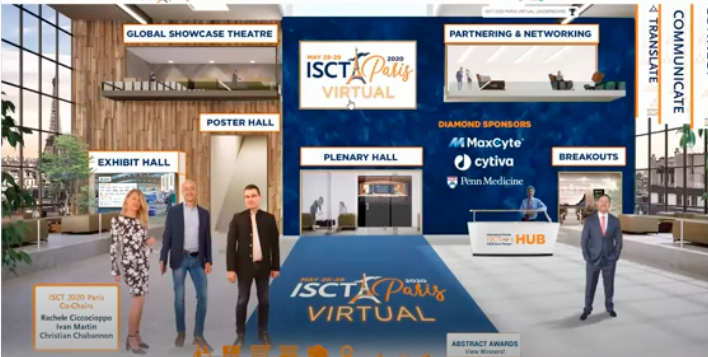Glenn MacLean is a Development Manager at CCRM where his focus is supporting company creation. Glenn obtained his PhD from Queen’s University while studying the role of retinoic acid metabolism during embryonic development. For post-doctoral studies, Glenn studied hematopoietic differentiation and lineage commitment at Boston Children’s Hospital. Outside of work, Glenn loves to escape to the woods and is passionate about canning and dehydrating food.
I recently attended my first virtual conference, ISCT 2020, which was originally planned to be held in Paris. I wasn’t sure what to expect from the virtual platform, but was pleasantly surprised as there were several things that I enjoyed about the conference. For instance:
- The interface was intuitive and well designed, making it easy to browse the schedule and access content.
- The presentations are archived and will be accessible until May 2021.
- It is much easier to take notes during virtual presentations, as talks can be paused and replayed.
- You have time to take notes that would otherwise be largely unintelligible by the time you reach home.
- There is no need to rush between lecture theatres during concurrent sessions or get lost in a conference centre, but maybe that’s just me?
The cons are that I missed attending the conference in person for spontaneous conversations and connecting with former colleagues. Also croissants, pain au chocolat, the Louvre….
There were many interesting talks at ISCT, highlighting advances in immunotherapy, cell manufacturing and therapeutics derived from pluripotent stem cells. It’s exciting to keep up with current discoveries and trends in these fields, but these are also areas where I regularly scan the literature.
One of my favourite things at conferences is to step out of my comfort zone and learn something entirely new; these are often the talks that I will remember the most. (One time I learned that elephants had over 20 copies of p53!) At ISCT that talk was “Resolution of cytokine storm associated with sepsis by apoptotic cells (Allocetra-OTS) administration” presented by Dr. Dror Mevorach of Enlivex Therapeutics.
Sepsis is a condition often initiated by infection, where the immune system can become overstimulated. This can result in a cytokine storm, which is the release of inappropriate levels of pro-inflammatory cytokines. This can manifest in multiple organ failure, and the mortality rate in cases of sepsis is 30-45 per cent.
Despite the medical need, there is no proven specific pharmacological treatment for sepsis. Dr. Mevorach presented data from a Phase Ib clinical trial, where mild-moderate sepsis patients were treated with Allocetra-OTS. This is an allogeneic product consisting of early apoptotic cells. It is proposed that administration of these apoptotic cells will be engulfed by macrophages, which will in turn result in a dampening of inflammatory signaling.
Results indicated that the therapy was safe, and well-tolerated. Furthermore, all patients survived with reduced ICU and hospital stay. Patients showed a resolution of organ disfunction, and pro-inflammatory cytokine levels steadily decreased after administration of Allocetra.
It should be stated that the experimental group consisted of 10 patients, and historical matched control patients were used as a reference, which are certainly limitations. However, given the lack of specific therapeutics for treatment of cytokine storm caused by sepsis, the results are compelling and the group is moving forward with a larger 160 patient Phase IIb trial.
In addition to the potential therapeutic effects in resolving sepsis, it will be interesting to see if this approach could also hold promise for treatment of CAR-T induced CRS (Cytokine Release Syndrome) or cytokine storm in cases of COVID-19.
Although far from my usual research interests, I found this talk intriguing. Initially the thought of administering apoptotic cells as a therapeutic was counter-intuitive to me. However, it sparked my interest and made want to learn more about this approach. What is the mechanism of action? How does one generate a consistent, defined population of apoptotic cells? Ultimately, Dr. Mevorach was successful in engaging my curiosity, something that as scientists we always find exciting. And isn’t that the main reason we attend conferences? Well, that and travelling to Paris.
Guest
Latest posts by Guest (see all)
- Regenerative immunotherapy: Hope for chronic autoimmune diseases - September 16, 2025
- Canada’s regenerative revolution: Why AI is the catalyst - September 4, 2025
- Summer by Design: A launchpad for future entrepreneurs and industry scientists - August 14, 2025







Comments